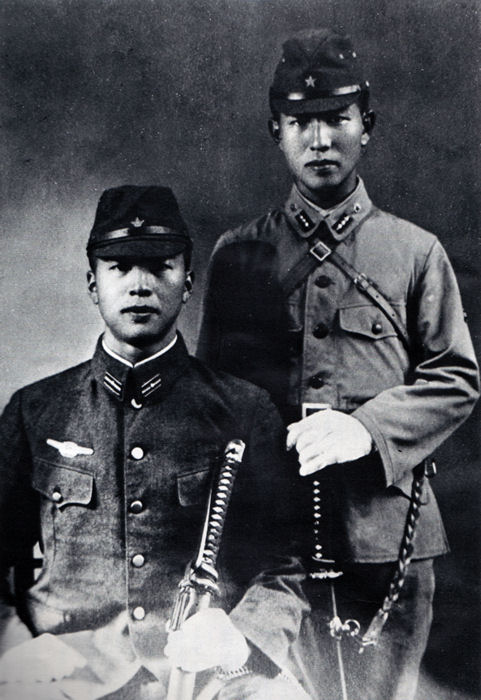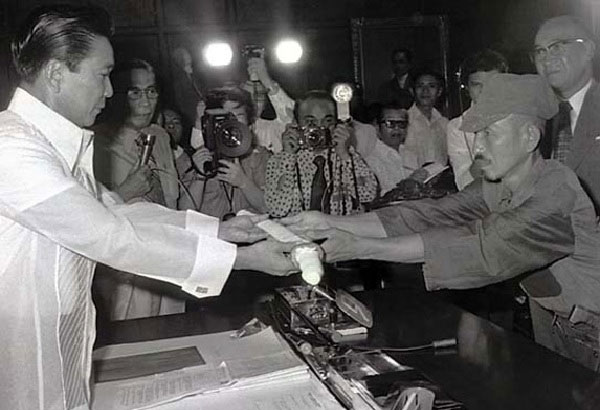|
Teruo Nakamura
was a Taiwanese soldier of the Imperial Japanese Army who fought for Japan in World War II and did not surrender until 1974. He was the last known Japanese holdout to surrender after the end of hostilities in 1945. Military service Nakamura was an Amis aborigine, born 8 October 1919. In November 1943, he enlisted in a Takasago Volunteer Unit of the Imperial Japanese Army. Nakamura was stationed on Morotai Island, in the Dutch East Indies, shortly before the Allies overran that island in the September 1944 Battle of Morotai. Allegedly, the Imperial Japanese Army declared Nakamura dead on 13 November 1944. After the Allies captured the island, it appears Nakamura remained there with other stragglers well into the 1950s, though setting off for extended periods on his own. In 1956, apparently, he relinquished his allegiance with his fellow holdouts, and set off to construct a solitary camp consisting of a small hut in a fenced field. Discovery Nakamura's hut was accidenta ... [...More Info...] [...Related Items...] OR: [Wikipedia] [Google] [Baidu] |
Chenggong, Taitung
Chenggong Township or Chengkung Township () is an urban township in Taitung County, Taiwan. It is a coastal town facing the Pacific Ocean. Chenggong Fish Harbor is just west of downtown. History Chenggong was originally an Amis settlement from which came the Hokkien name Moalaulau (). During Japanese rule, it was renamed to of Taitō Prefecture. After 1945, to avoid confusion with Singang Township of Chiayi County and to distinguish it from Tainan's Sinckan (now called Sinshih), it was changed to Chenggong, which commemorates the eponymous general Koxinga (Cheng Ch'eng-kung) who expelled the Dutch from Taiwan. Geography The township has 13,193 inhabitants and its total area is 144.9938 km². Climate Along with most of the rest of Taitung County, Chenggong has a Tropical rainforest climate. Administrative divisions * Bo'ai Village 博愛村 * Heping Village 和平村 * Sanmin Village 三民村 * Sanxian Village 三仙村 * Xinyi Village 信義村 * Zhongren Vil ... [...More Info...] [...Related Items...] OR: [Wikipedia] [Google] [Baidu] |
Indonesian Air Force
The Indonesian Air Force (, sometimes shortened as IDAF / IdAF) is the Air force, aerial branch of the Indonesian National Armed Forces. The Indonesian Air Force is headquartered in Jakarta, Indonesia, and is headed by the Chief of Staff of the Indonesian Air Force, Chief of Staff of the Air Force ( – KSAU or KASAU). Its order of battle is split into three Air Operations Commands (). Most of its airbases are located on the island of Java. The Indonesian Air Force also has its ground force unit, called Air Force Quick Reaction Force Command (Kopasgat). The corps is also known as the "Orange Berets" () due to the distinctive color of their service headgear. The Indonesian Air Force has 30,100 personnel and equipped with 110 combat aircraft. The inventory includes 33 F-16 Fighting Falcons as the main fighters (from the United States) supplemented by five Su-27 and eleven Su-30 (from Russia), British Aerospace Hawk 200, Hawk 200, KAI T-50 Golden Eagle, KAI T-50 and Embraer EMB 31 ... [...More Info...] [...Related Items...] OR: [Wikipedia] [Google] [Baidu] |
1979 Deaths
Events January * January 1 ** United Nations Secretary-General Kurt Waldheim heralds the start of the ''International Year of the Child''. Many musicians donate to the ''Music for UNICEF Concert'' fund, among them ABBA, who write the song ''Chiquitita'' to commemorate the event. ** In 1979, the United States officially severed diplomatic ties with the Republic of China (Taiwan). This decision marked a significant shift in U.S. foreign policy, turning to view the People's Republic of China as the sole legitimate representative of China. ** The United States and the People's Republic of China establish full Sino-American relations, diplomatic relations. ** Following a deal agreed during 1978, France, French carmaker Peugeot completes a takeover of American manufacturer Chrysler's Chrysler Europe, European operations, which are based in United Kingdom, Britain's former Rootes Group factories, as well as the former Simca factories in France. * January 6 – Geylang Bahru family ... [...More Info...] [...Related Items...] OR: [Wikipedia] [Google] [Baidu] |
1919 Births
Events January * January 1 ** The Czechoslovak Legions occupy much of the self-proclaimed "free city" of Bratislava, Pressburg (later Bratislava), enforcing its incorporation into the new republic of Czechoslovakia. ** HMY Iolaire, HMY ''Iolaire'' sinks off the coast of the Hebrides; 201 people, mostly servicemen returning home to Lewis and Harris, are killed. * January 2–January 22, 22 – Russian Civil War: The Red Army's Caspian-Caucasian Front begins the Northern Caucasus Operation (1918–1919), Northern Caucasus Operation against the White Army, but fails to make progress. * January 3 – The Faisal–Weizmann Agreement is signed by Faisal I of Iraq, Emir Faisal (representing the Arab Kingdom of Hejaz) and Zionism, Zionist leader Chaim Weizmann, for Arab–Jewish cooperation in the development of a Jewish homeland in Palestine (region), Palestine, and an Arab nation in a large part of the Middle East. * January 5 – In Germany: ** Spartacist uprising in ... [...More Info...] [...Related Items...] OR: [Wikipedia] [Google] [Baidu] |
Guam
Guam ( ; ) is an island that is an Territories of the United States, organized, unincorporated territory of the United States in the Micronesia subregion of the western Pacific Ocean. Guam's capital is Hagåtña, Guam, Hagåtña, and the most populous village is Dededo. It is the List of extreme points of the United States#Westernmost points, westernmost point and territory of the United States, as measured from the geographic center of the United States, geographic center of the U.S. In Oceania, Guam is the largest and southernmost of the Mariana Islands and the largest island in Micronesia. As of 2022, its population was 168,801. Chamorros are its largest ethnic group, but a minority on the multiethnic island. The territory spans and has a population density of . Indigenous Guamanians are the Chamorro people, Chamorro, who are related to the Austronesian peoples, Austronesian peoples of the Malay Archipelago, the Philippines, Taiwanese indigenous peoples, Taiwan, and Polyne ... [...More Info...] [...Related Items...] OR: [Wikipedia] [Google] [Baidu] |
Shoichi Yokoi
was a Japanese soldier who served as a sergeant in the Imperial Japanese Army (IJA) during the Second World War, and was one of the last three Japanese holdouts to be found after the end of hostilities in 1945. He was discovered in the jungles of Guam on 24 January 1972, almost 28 years after U.S. forces had regained control of the island in 1944. Biography Yokoi was born in Saori, Aichi Prefecture, Japan. He was an apprentice tailor when he was conscripted in 1941."Shoichi Yokoi" ''Ultimate Guam''. Initially, Yokoi served with the 29th Infantry Division in . In 1943, he was transferred to the 38th Regiment in the |
Philippines
The Philippines, officially the Republic of the Philippines, is an Archipelagic state, archipelagic country in Southeast Asia. Located in the western Pacific Ocean, it consists of List of islands of the Philippines, 7,641 islands, with a total area of roughly 300,000 square kilometers, which are broadly categorized in Island groups of the Philippines, three main geographical divisions from north to south: Luzon, Visayas, and Mindanao. With a population of over 110 million, it is the world's List of countries and dependencies by population, twelfth-most-populous country. The Philippines is bounded by the South China Sea to the west, the Philippine Sea to the east, and the Celebes Sea to the south. It shares maritime borders with Taiwan to the north, Japan to the northeast, Palau to the east and southeast, Indonesia to the south, Malaysia to the southwest, Vietnam to the west, and China to the northwest. It has Ethnic groups in the Philippines, diverse ethnicities and Culture o ... [...More Info...] [...Related Items...] OR: [Wikipedia] [Google] [Baidu] |
Lubang Island
Lubang Island is the largest among the seven islands in the Lubang Group of Islands, an archipelago situated to the northwest of the northern tip of the island of Mindoro in the Philippines. It is positioned approximately 40 kilometers west of Calatagan, Batangas, or 117 kilometers southwest of Manila. The Lubang Group of Islands is under the jurisdiction of the province of Occidental Mindoro and divided into two municipalities. The principal settlement is the town of Lubang, located at the northwest section and about 11 kilometers northwest of Tilik Port. The southeastern portion of the Lubang Island falls within the municipality of Looc, which also operates a port in a different area, specifically in Barangay Agkawayan. Lubang Group of Islands stands as a distinct geographical entity isolated from any landmass, rendering it biologically unique and also endangered. Geography Northwest to southeast the four main islands are Cabra, separated by a deep, wide channel from Lubang ... [...More Info...] [...Related Items...] OR: [Wikipedia] [Google] [Baidu] |
Hiroo Onoda
was a Japanese soldier who served as a second lieutenant in the Imperial Japanese Army during World War II. One of the last Japanese holdouts, Onoda continued fighting for nearly 29 years after the war's end in 1945, carrying out guerrilla warfare on Lubang Island in the Philippines until 1974. Onoda initially held out with three other soldiers: one surrendered in 1950, and two were killed, one in 1954 and one in 1972. The men did not believe flyers and letters from their families stating that the war was over. They survived on wild fruits, game, and stolen rice, and occasionally engaged in shootouts with locals and the police. Onoda was contacted in the jungles of Lubang by a Japanese adventurer in 1974, but still refused to surrender until he was formally relieved of duty by his former commanding officer, Major Yoshimi Taniguchi, who flew from Japan to the island to issue the order. Onoda surrendered on 10 March 1974, and received a hero's welcome when he returned to Japa ... [...More Info...] [...Related Items...] OR: [Wikipedia] [Google] [Baidu] |
Lung Cancer
Lung cancer, also known as lung carcinoma, is a malignant tumor that begins in the lung. Lung cancer is caused by genetic damage to the DNA of cells in the airways, often caused by cigarette smoking or inhaling damaging chemicals. Damaged airway cells gain the ability to multiply unchecked, causing the growth of a tumor. Without treatment, tumors spread throughout the lung, damaging lung function. Eventually lung tumors metastasize, spreading to other parts of the body. Early lung cancer often has no symptoms and can only be detected by medical imaging. As the cancer progresses, most people experience nonspecific respiratory problems: coughing, shortness of breath, or chest pain. Other symptoms depend on the location and size of the tumor. Those suspected of having lung cancer typically undergo a series of imaging tests to determine the location and extent of any tumors. Definitive diagnosis of lung cancer requires a biopsy of the suspected tumor be examined by a patholo ... [...More Info...] [...Related Items...] OR: [Wikipedia] [Google] [Baidu] |
Hirō Onoda
was a Japanese soldier who served as a second lieutenant in the Imperial Japanese Army during the Pacific War, Imperial Japanese Army during World War II. One of the last Japanese holdout, Japanese holdouts, Onoda continued fighting for nearly 29 years after the End of World War II in Asia, war's end in 1945, carrying out guerrilla warfare on Lubang Island in the Philippines until 1974. Onoda initially held out with three other soldiers: one surrendered in 1950, and two were killed, one in 1954 and one in 1972. The men did not believe flyers and letters from their families stating that the war was over. They survived on wild fruits, game, and stolen rice, and occasionally engaged in shootouts with locals and the police. Onoda was contacted in the jungles of Lubang by a Japanese adventurer in 1974, but still refused to surrender until he was formally relieved of duty by his former commanding officer, Major Yoshimi Taniguchi, who flew from Japan to the island to issue the order. ... [...More Info...] [...Related Items...] OR: [Wikipedia] [Google] [Baidu] |





